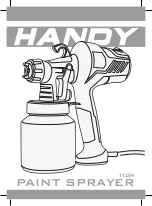
5.5
Retooling of Spray Gun
Combinations of air cap, material needle, designed to match specific spraying
media types and grades, form a unit - namely the nozzle insert assembly, which must
always be interchanged as a complete assembly to maintain the desired spray-finish
quality standard.
Warning
Prior to retooling: make sure that the spray gun is in unpressurized condition, i.e. all air
and material inputs must be shut off - if not, imminent Risk of Injury.
Notice
Please use the drawing and the list of replacement parts at the beginning of these
Operating Instructions in order to perform the operating steps presented hereafter.
Replacement of Material Nozzle and Needle
1. Unscrew the air cup nut (item 1) and the air cap (item 2).
2. Unscrew the material nozzle (item 3) and the spring retaining bush (item 27) from
the gun body (item 14) (SW 9 a. SW 22).
3. Pull out the complete needle insert from the gun body.
4. Unscrew the pull bar (item 34) from the piston (item 19).
5. Remove the valve spring (item 26).
6. Unscrew the piston-screw (item 25) from the piston.
7. Remove the piston-disk (item 24), the cup seal (item 23) and the needle-spring
(item 22).
8. Pull out the material needle (item 20) from the piston.
9. Screw out both needle-nuts from the needle (item 21) (SW 3).
Installation of the new material nozzle and needle is performed in reverse order.
Notice
The slip gauge of the material needle is 96 mm from the needle tip to the first needle -nut.
Notice
Apply a thin film of grease to the following components during assembly: cup seal
(item 23), valve spring (item 26).
6 Cleaning
6.1 Safety
Warnings
• Make sure that the spray gun is in unpressurized condition, i.e. all air and material
inputs must be shut off - if not, imminent Risk of Injury.
• Open fires, naked lights and smoking is prohibited in the working area. There is an
increasing risk of fire and explosion, when spraying readily flammable media (such as
cleaning solutions).
• Observe all processing specifactions and safety warnings issued by the manufactu-
rer of cleaning media. Especially aggressive and corrosive media represents risks
and hazard to personal health.
8
6.2
Cleaning - Complete
The spray gun should be frequently cleaned and lubricated so as to ensure a long
service life and functional reliability.
Clean the gun only with cleaning solutions recommended by the manufacturer of
the spraying material, which do not contain any of the following constituents:
• halogenated hydrocarbons (e.g. 1,1,1, trichloroethane; methylene chloride, etc.)
• acids and acidiferous cleaning solutions
• regenerated solvents (so-called cleaning dilutions)
• paint removers
The above constituents cause chemical reactions with electroplated components
resulting in corrosion damage.
WALTHER PILOT is not responsible for damages resulting from this kind of treat-
ment.
Clean the spray gun
• prior to each change of the spraying medium
• at least once a week
• as often as may be required by the spraying medium handled and the resulted
degree of fouling.
Caution
Never immerse the spray gun in solvent or any other cleaning solution as such
measure is very likely to affect the functional reliability and efficiency of the gun.
Caution
Do not use any hard, pointed or sharp-edged objects when cleaning the spray
gun, as the precision-made parts can be easily damaged and are likely to affect
your spraying results.
1. Dismantle the spray gun acording to 5.5
Replacement of Material Nozzle and
Needle
2. Use a soft brush together with a compatible cleaning solution to clean the air
cap and material nozzle
3. Use a suitable cloth with a compatible cleaning solution to clean the gun body
and all remaining parts
4. Apply a thin layer of grease to the following parts:
• cup seal (item 23)
• valve spring (item 26)
Make sure to use a non-acidic, non-resinogenic grease and apply this with a soft
brush. Assemble the spray gun in reverse order.
9
















































